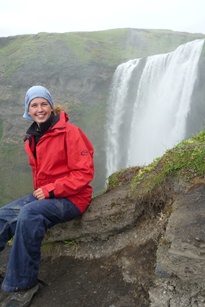I study the degassing of subglacial volcanic systems in Iceland. My PhD was based at the rhyolite central volcano Torfajökull. We reconstructed palaeo-ice thicknesses and determined the role of volatiles in determining how explosive the eruptions were. Now I am doing a post-doc on the 1918 eruption of Katla. We will look at the way in which Katla degassed and interacted with the overlying ice. Hopefully, by understanding what was controlling explosivity in the 1918 eruption we can help to mitigate and plan for the next eruption.
Volatiles in Icelandic subglacial rhyolite
Magmatic volatiles from subglacial edifices offer useful insights into palaeo-ice thicknesses and during subaerial eruptions are a strong influence on eruptive behaviour. However, pre-eruptive volatile concentrations and degassing paths are lacking from subglacially erupted edifices and thus the role of volatiles in determining the explosivity of subglacial eruptions remains unclear. The eruptive mechanisms of subglacial rhyolite are particularly poorly understood as such an eruption has not occurred during recent history. Furthermore, the pre-eruptive volatile content of Icelandic rhyolite is poorly constrained.
I have measured the volatile content of melt inclusions and matrix glasses from five subglacial rhyolitic edifices in Iceland, which formed through contrasting eruptive behaviour. I provide the first chamber to surface degassing profiles for subglacial volcanism and used their residual volatile contents to reconstruct quenching pressures and thus palaeo-ice thicknesses.
Volatile-based estimates of the palaeo-ice surfaces for Bláhnúkur (1,000 m a.s.l.), Dalakvísl, (1,020 m a.s.l.) and Angel Peak (1,120 m a.s.l.) are broadly consistent with estimates made from the subglacial-subaerial transition of tuyas thought to have formed at a similar time (1,090 m a.s.l.). Relative differences between samples have been interpreted as showing intrusive formation for some of the facies at Bláhnúkur, and a syn-eruptive jökulhlaup during the formation of Dalakvísl, thus offering useful insight into edifice construction and the associated hazards.
Pre-eruptive volatiles contents reveal that effusive magma had relatively low pre-eruptive H2O contents (up to 2.9 wt.%), slow ascent rates and experienced open system degassing, whereas explosive magma had up to 4.8 wt.% H2O, fast ascent rates and closed system degassing. Thus the role of volatiles in subglacial systems seems similar to the role played in subaerial eruptions in terms of influencing eruptive behaviour. Furthermore, measured H2O contents are much higher than was expected of Icelandic rhyolite, which is generally considered to be ‘dry’.
